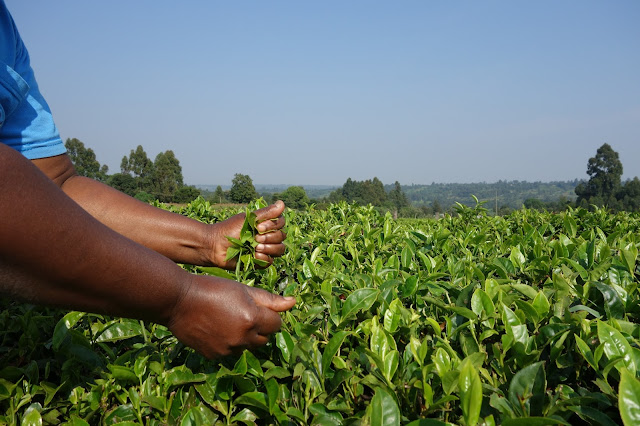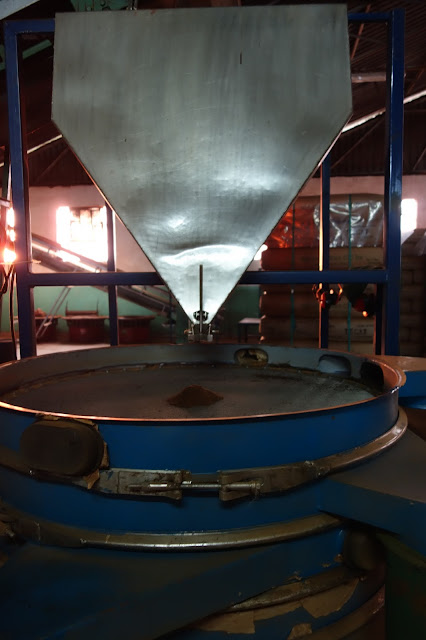 |
| Unilever Tea Estate, with the Mau forest in the background |
Tea (or ‘chai’
in Swahili) plays a big role in Kenyan culture whilst also being the country’s
largest export. Luckily enough Kenya grows more then it consumes and so has
plenty to export around the world. Majority of Kenyan tea comes from Kericho, a
small, but extremely lush county west of the rift valley. The high altitude,
cool climate and fertile soil helps produce some of the world’s most desirable black
tea: rich in flavor and dark in colour.
Most of the
tea plantations in Kericho are owned by large companies; Unilever, Brook Bonds,
and James Finlay. Since the
beginning of large-scale tea production in the 1930s, these companies have
dominated the Kenyan Tea market, buying out acres of land for the production of
tea. These vast areas, called “tea estates”, can be seen east of Kericho town,
on the way to Nairobi. As well as processing factories and small offices, tea
estates also have housing facilities for their workers, majority of whom have
traveled from around the country to be part of this lucrative industry.
As with most tea
estates around the world, the carpet of green tea gardens as far as the eye can
see is a sight to behold. Dotted with trees, and maybe the odd factory or two, one
begins to comprehend the drastic impact humans have had on our natural
environment. The exploitation of the land for harvesting cash crops is only
realised when one visits the Mau forest which once extended from Western Kenya through
to Uganda, Rawanda and all the way to the Congo. This once dense forest was cut
down by the British to make way for the rolling tea plantations. The same vast
tea estates are also largely responsible for the growth in Kenya’s economy,
putting it on the international trade map.
If you were
to go east of Kericho town, you will see an entirely different tea landscape.
Here, smaller patches of tea gardens pop up amongst forests and farmland. This
is where smallholding tea farmers live, and have lived for generations. The people
here are indigenous Kipsigis people who started to grow Tea when the British
first introduced it around a century ago. Majority of the farmers make most of
their living from tea production, and tend to have a number of buyers they
supply to. This keeps prices competitive as well as ensuring high quality tea.
 |
| Kareena's Family Tea Plantation, mid morning |
I visited
Kericho with a good friend of mine in early July 2013. We stayed with a friend
of ours called, Kereena, whose family owned a smallholding tea farm. Her
grandfather, who gave each son a portion to grow tea on, had divided the land
up. This subsequently will happen to Kereena and her brothers and sisters. It
does make one question though, how much can a land be divided before it loses
its value?
 |
| Walking around the family plantation with Mama Kareena and Kareena's cousins |
We walked
around the family plantation, which seemed well organised and easy enough to
navigate. Amongst the tea gardens were fruit trees and designated areas for
growing maize. We were told that the tea bushes never stop producing tealeaves,
as long as they are maintained well, which means regular pruning. The bushes
should never exceed 4 meters. Kareena’s granddad first planted the Tea bushes in
the sixties. The same tea bushes still exist and still produce high quality tealeaves.
 |
| Tea pickers |
Due to the enormity
of their tea gardens, Kareena’s parents outsourced a few local women to pick
leaves on their behalf. I was told that an average picker could pluck up to
50kg of leaves a day. As the tea pickers are paid by weight, they are expected
to pick about 6-10kg an hour to earn a decent wage. Unlike on the tea estates,
where scissors are used, these women picked the tea by hand, which ensures only
the best leaves are picked and no that no leaves are damaged in the process.
 |
| Plucking tea |
Picking tea
by hand is a skill to master. It needs a good eye and a couple of speedy hands.
Only the top two leaves on the plant should be picked, leaving some stem. This
is called a “fine plucking”.
 |
| "fine plucking" |
The leaves
are collected and then taken to buying stations where the bags of leaves are
randomly sampled, weighed and the farmer is given some money in exchange for
the tea they have picked. Prices can range from 15ksh – 60ksh (12p – 48p) per
kilo depending on the buying company.
We went to
visit one of the more ethical buying and processing companies in the area that
Kareena’s family supply to:
 |
| Tegat Tea Factory, Kericho |
The Tegat Tea
Factory was initially built in 1971 by the James Finley co. It was later bought
three years later, in 1974, by the Kenyan Tea Development Agency, the leading
management agency for small scale tea farmers in Kenya. This means that the
factory and the running of operations is owned and controlled by the farmers,
who select the board members and have the largest stake in the company.
The tea
processed by the factory comes from approximately 9000 different farmers all
within a 12km radius of the factory. Consistency is maintained by the KTDA who
regularly visit farmers and their farms to ensure high standards are kept. They
also supply the farmers with any farming inputs they may need, like fertilisers
and seeds. This is all supported by the Kenyan Tea Research Foundation who are
consistently developing better and more efficient ways of growing tea.
The Tegat Tea
Factory processes between 20,000 – 100,000 kg of leaves a day. Most of the tea is
exported to the UK, Pakistan, Egypt and even Afganistan. Companies that buy the
tea, include Tetleys, Lipton, and Taylors of Harrogate. The tea is Rain Forest
Alliance Certified, which makes it highly desirable by tea companies that want
to appeal to the new “ethical market”. Unsurprisingly enough, most of the
smallholding farms had to go through little or no changes to achieve this
status.
The
processing of the tea takes around 3hr from start to finish:
 |
| Leaves are dried over fans for 2hrs |
 |
| The leaves are then chopped and rotated, then fermented by being oxidised |
 |
| The leaves still have 65% moisture content, this is removed by steam drying five times |
The tea comes out ungraded and is perfectly suitable for human consumption at this point. Although for the international market, the tea has to be graded, not according to taste (as it all tastes the same) but according to size:
Grade1:
larger leaf, creates a light liquor; Grade2: Medium Leaf, creates a semi thick
liquor; and Grade3: small leaves, creates a thick liquor.
The tea is graded
using a large sieve which separates the tea into it’s three different grades.
Now, this
only matters because different countries have different preferences and trends
for their tea. For example, in the UK teabags are the preferred method, and
because the tea only need a short time in water, grade 3 leaves are used. In
Pakistan, where lose tea is brewed in a pot, grade 1 leaves are used.
 |
| Large sieve which grades the tea |
Grading tea
is a curtail stage as prices for each grade change according to market demand.
This inevitably affects the price of the other grades. This can be witnessed
first hand at the largest Tea Trading House in the world which in on the East
Coast of Kenya in the port city of Mombasa. Here is where tea is tasted, and
bought before entering the world market.
 |
| Graded Tea: (left to right) grade 1, grade 2 and grade 3 |
As one of the
world’s largest consumers of tea, the UK has a vested interest in tea
production globally. As demands grow, we need to think about how they can best
be met. Are we willing to sacrifice quality? Will we sacrifice Mother Nature?
Or are we even willing to sacrifice our much loved commodity? I was really
inspired by how Tegat and the KTDA were managing tea production to meet
international markets. Their approach which put small scale farmers in control,
not only ensures less land degradation but also allows empowers farmers to make
the right choices when it comes to the management of their tea production.
As our time
in Kericho came to an end we watched the sun set over the tea planations whilst
tea pickers walked home, I began to realise how important the tea industry is
to Kenya. As the country’s largest export for the last forty years, tea has
help shaped Kenya into one of the most powerful countries on the continent. As
this. continues, I hope more and more that we will see more factories like Tegat, which will give Kareena’s family the opportunity to buy more smallholdings for
future generations. The tea we love so much is also a means to a living for
many people around the world. Choosing and supporting the right brand is not
only good for the farmers, but also for the environment and most importantly
for the future of the industry. Maybe that next time I chose which tea I want
in my cup, I will think about what kind of future Kareena and her family would
like for the future of tea production in Kenya.
 |
| Sunset over smallholding tea plantations, Kericho |

if farmers r to earn gigantic proceeds out tiz precious tea,tey shd elect vibrant directors who wd pressurise KTDA BOARD to enact rules allowing vibrant local consumption by way sellin to various shops n malls on credit .also t political leaders shd enact laws demanding markt search by t board-approved agents rather than auctioning,since tat(auctioning) would cut out a large portion of profit to farmers
ReplyDelete